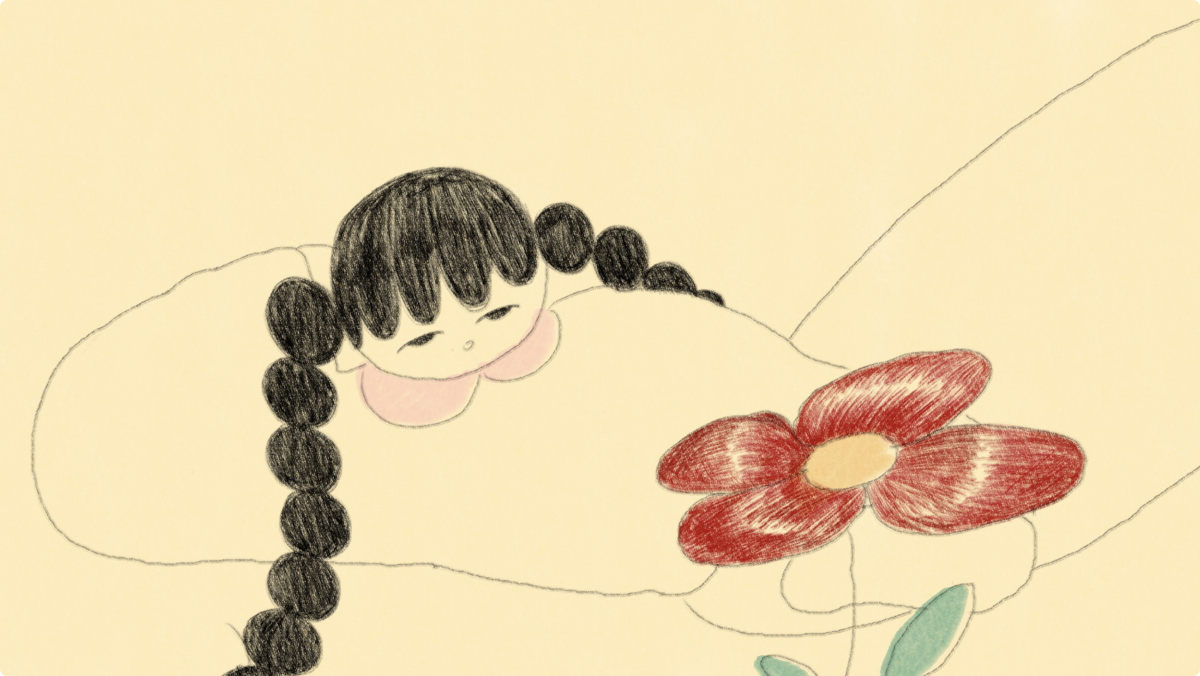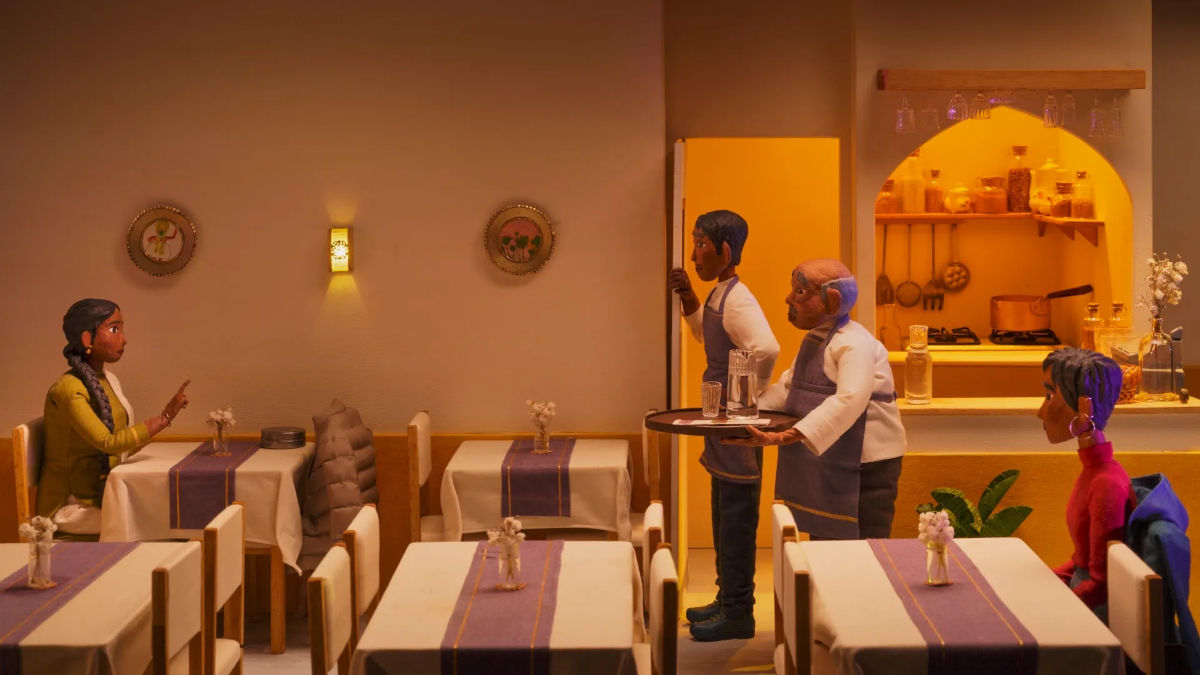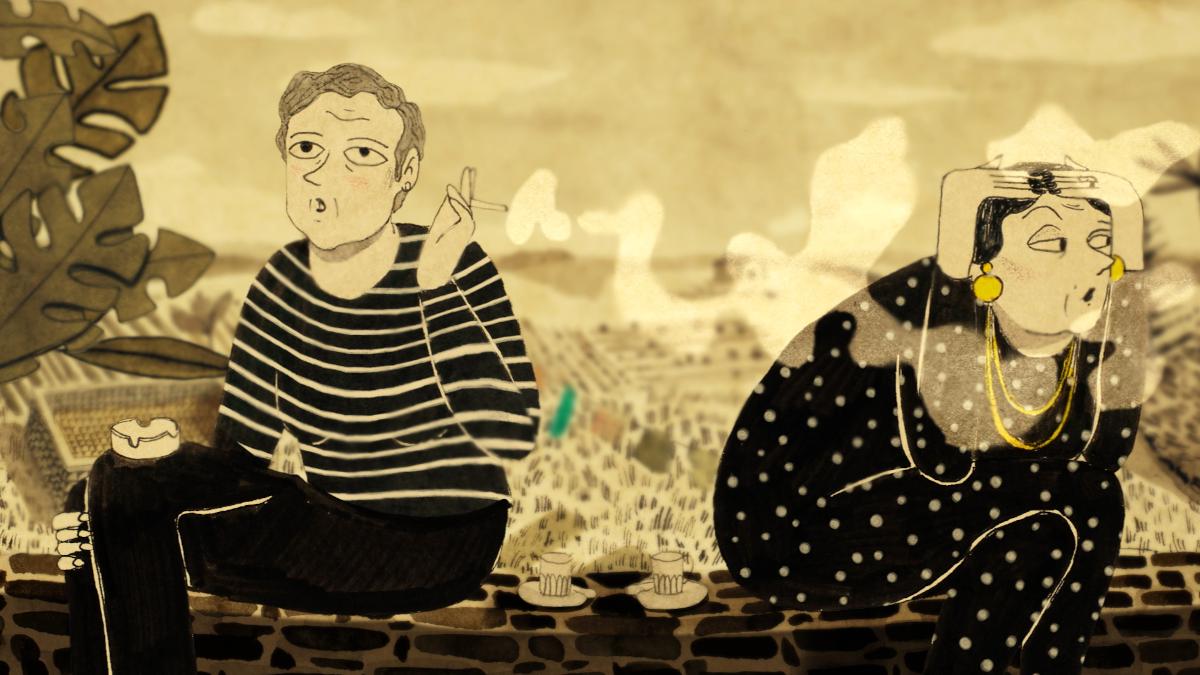Independent Animation Shorts
The Italian Gaze by Sandro Del Rosario
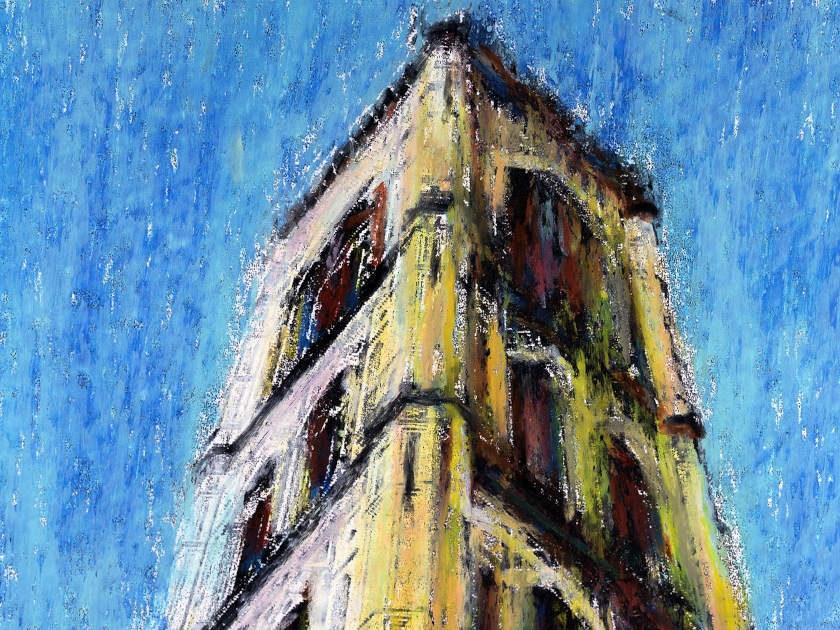
Τhe animation short 'The Italian Gaze' was a 11-year effort for Sandro Del Rosario, starting since summer 1999, and his summer Florence days (after the first year of his CalArts studies) -filled with Italian beauty, but also with a lot of uncertainty regarding his own financial future. But still Florence and its city Duomo did the trick: "Its magnificent dome by Brunelleschi was standing out against the roofs, and this view raised a powerful emotion in my heart, combining personal frustration and the impossibility to imagine a future there with the ecstatic contemplation of the city unique beauty, of the pulse of its history which was still so present. In those days, I began to think about a new project, initially dedicated to Florence, and sketched the first images"
Another and longer sojourn in Italy that lasted four years after his graduation had an indelible mark on the author, combining personal feelings and artistic translation ("A myriad of emotions, good and bad, would gather inside me pushing to be transformed into something that I could share with others"). Finally, a 2005 residency at the Bogliasco Foundation greenlit the project Lo Sguardo Italiano ('The Italian Gaze')
"The concept for this film, the coexistence of a sense of awe and belonging with disappointment and sadness, didn’t changed through the 11-year effort to make the film. It sustained it" Sandro Del Rosario tells Zippy Frames. "But the material did evolve inevitably". The material (taking photos in 35mm camera and videos in analog hi8) was amassed as early as 1999 Florence, and obviously -and massively-edited; the rest was obtained during the 2005 residency (' I was so moved by the view of the Mediterranean Sea and by the city of Genova, that I elected that landscape to represent symbolically the entire country. Many of the photos and videos that became part of my film come from that area').
Watch The Italian Gaze:
The director wrote himself the text, characterising himself as 'fed with books, poetry and fiction writing' during his formatting years; in his previous film, 'L.City', words pre-existed the film. In 'The Italian Gaze' the text later complemented the visuals.
The visuals themselves are a different story. ' I wanted to isolate, magnify, and make those moments more abstract at first, so I began to print both photos and video frames out on paper, in black and white and with high contrast. After being printed out, those images were photocopied over and over, until they would lose their details, down to only a grayish ghost of the original frame. Each image measured about 10 x 13.5 cm'. These images now became the source material.
Color was the next step, and oil pastels were used ('for their brilliance, their saturation and their ability to stick on the photocopy paper'). Sandro Del Rosario fell in love with all those different kinds and varieties and pastel tones, which was a second kickoff to what he describes as 'his labyrinth of my memory, on the pages of my photocopied stripes'.
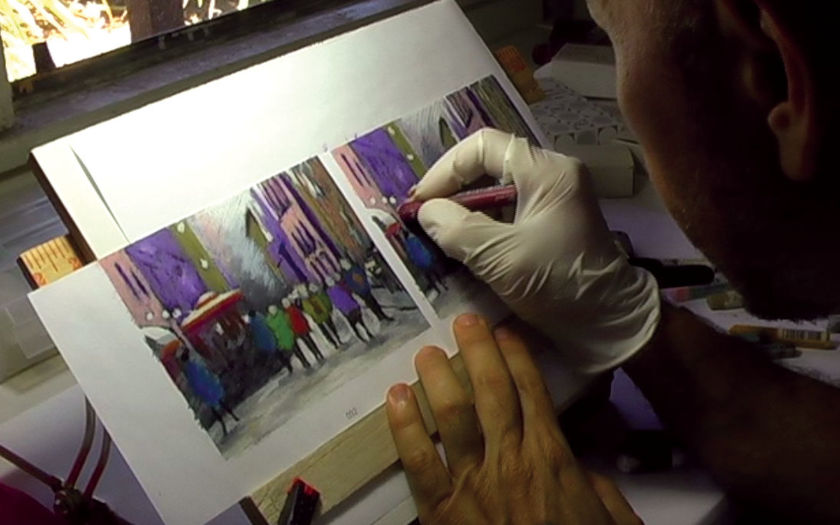
Color was Del Rosario's shorthand for emotions ('Painting the material was a conscious act of creation'), but movement became another shorthand for renewed image life. ' I shot the images one by one, compositing them as sequences, and testing their smoothness. Sometimes I had to eliminate some images; other times I had to change the animation pace. I settled on shooting “on threes”, with an average of eight-ten images per second. At the end, eleven years after beginning to work on this film I had colored thousands of images, almost six thousand. With all these images, I was able to create fourteen minutes of film'.
Computers were used at the first stage, of photo selection and video editing as still frames (and Photoshop to transform all photos in black and white, adjust and alter their contrast). After the bulk of the coloring process was done entirely by hand, computer use returned for the film shoot (after abandoning the decision to shoot in 16mm). 'I used a digital still camera and shot RAW format high-res images. Then I used Camera RAW (professional photo retouching) to eliminate all the tiny spectacles of dust that had stuck on the pastels. Unfortunately, I had discovered soon that those tiny dots, when blown up on the screen, would flicker a lot, creating a stroboscope effect that could disturb the flow of the animation. This painstaking task took a long time'.
Digital color balancing followed, and most accurately captured in the DCP of the film, the director's preferred means of viewing the film. The film format in 4:3 has its own story as well. 'When I began my journey as a filmmaker,16mm film was still the preferred widespread format for independent and experimental films. The aspect ratio of 16mm is 4:3. I never thought I could afford to shoot in 35mm, so I stuck to that format. And I was interested in making a film to be seen in the dark of a movie theater, not on the monitor of a computer.
When the shift to digital became more apparent, Del Rosario experimented with the 16:9 format, yet in the end 4:3 won -and it is the one to be used in film's theatrical screenings as well ('I honestly never imagined or desired to show my film on phones…but that’s a different story').
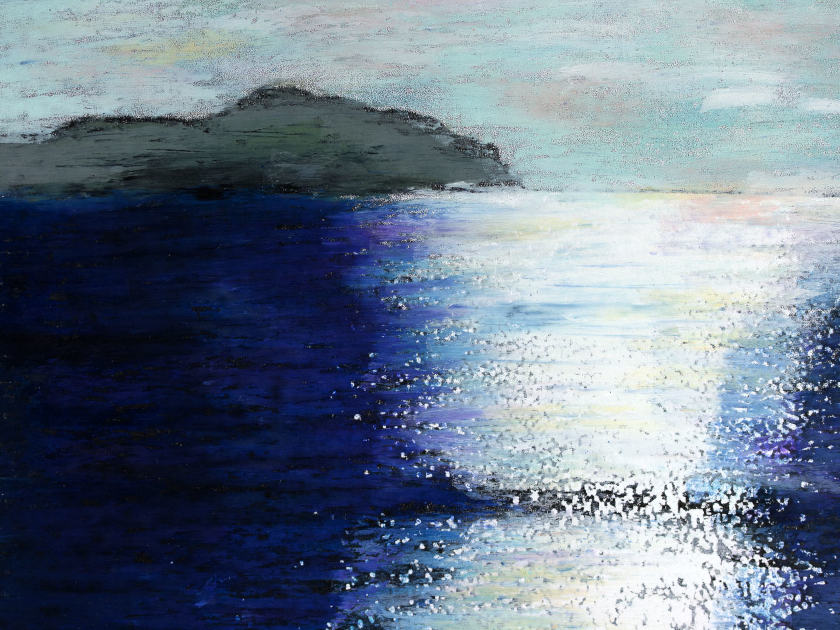
Finding the budget proved to be a source of constant concern; grant applications were made. Art residencies proved instrumental (besides Bogliasco, MacDowell and Yaddo up in the Northeast of the US as well as Ucross, in Wyoming, among the others). After many years of alternating full-time work with full-time film production, a 2014 Kickstarter campaign followed ('found some incredibly generous donors'). Del Rosario also cites renowned Italian animation scholar Giannalberto Bendazzi as a source of support and inspiration. 'Each challenge renewed my commitment towards this film. The theme was so important for me, and the investment so extensive that I couldn’t let it go', he states.
The sea and the stones alternate in the film as two major themes, water and solidity. "Returning to the sea is always a special experience to those who were born on the coast' Del Rosario states. ' Nature has an ancient pull on all of us. And it is even stronger when it comes from our hometowns. But in this film the sea has a symbolic value, it represents the cycle of life, defines Italy’s geography and identity, it is key to the history of my country. One of the first challenges I had in making this film was understanding how to communicate the disappointment and the sorrow for the issues that are affecting contemporary Italy, while also expressing the love for the art, the architecture, and the landscape. The metaphor of the stones came out as the solution only after a second fellowship and residence at the Bogliasco Foundation, in Liguria'.
Here Del Rosario found out the bad side of Italian political life: corruption, economic crisis, environmental disasters ('I was never happy about Italy’s political situation, and things never improved. This is still a big issue for me, one I feel unable to change'). The Pescara-born artist (now living in the L.A.) has learnt to constantly shift his horizons, from the minute to the big . 'In the past, I confronted myself with Italy’s regional dimension, with its deep differences and divisions. After visiting other European countries, I appreciated macro-diversities'.
But, back in Italy for the film, he spent hours looking out of the sea, from those small coast inlets full of stones. 'The submerged stones carried to the shore by water were a metaphor that fit perfectly the situation described in the newspapers: words (like water) went away, while their weight (the stones) remained'.
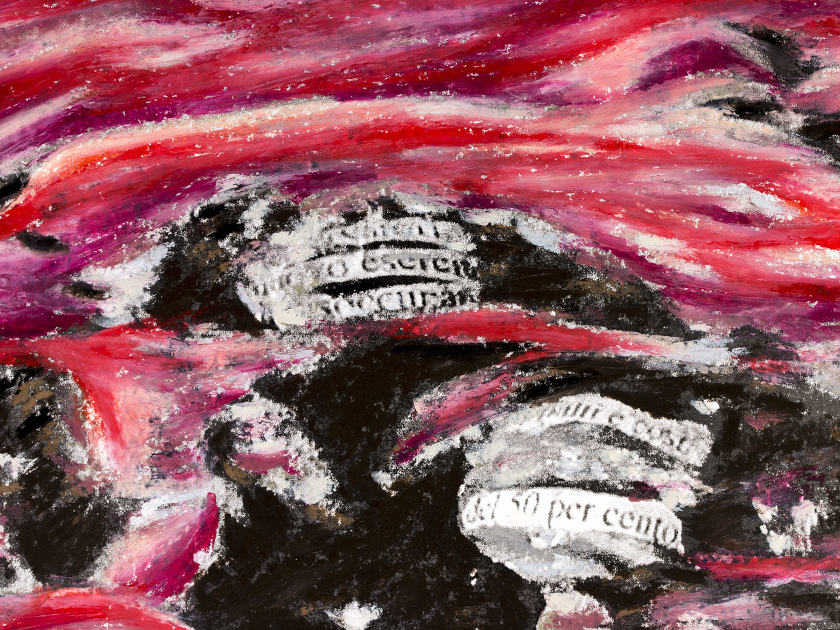
Music (by Michele Di Toro) is also distinctive in the film, and unlike earlier films, improvisation was not needed. 'I knew exactly what I wanted in terms of music. I had been working on the sound on my own, while listening to music composed by various musicians. When I discovered the work of Michele Di Toro, a jazz and classically trained pianist who coincidentally was from my same Italian region, I thought I found my composer'. One of Di Toro's compositions was specifically adapted for the film, a lyrical piano tune, and the end credits theme. An impromptu variation on it was created for the stone sequence.
'The Italian Gaze' (in both its English and Italian version) is a prime example of independent animation and its hurdles, and especially the variety of experimental animation. 'It's almost funny (except that is not) that twenty-three years after emigrating to the United States for it, I see experimental animation in the US like an orphan child, endlessly looking for parental support' Sandro Del Rosario will attest. Even though he won't diminish the importance of his CalArts alma mater, he still notes the complete absence of funds for anything apart from the big US animation industry. Yet for him animation and experimentation (not a single way to do it) are always sources of inspiration, despite his meagre commercial returns, and amount of dedication required. Call it the experimental gaze.
Film Review (Vassilis Kroustallis):
A three-act structure of initial awe, subsequent doubt and final reconciliation is evident in the sensitive travelogue of 'The Italian Gaze'. Sandro Del Rosario makes his entrance with his camera as a tourist struck by the Italian natural and cultural beauty; then he steps back by reading the latest political news, before he is able to remove himself from the temporal to the universal. This journey in impressionistic images, carefully painted to give an overriding inescapable effect of a rich but also moving locale, is also poignantly sustained with the piano theme and the narration -acting like your local travel guide in an esoteric mood. 'The Italian Gaze' reveals its painstaking procedure in the making, but also leads you beyond its imagery to an inner life reflected upon the imagery itself. It is empathetic, past-and-present-time conscious and a labour of love.
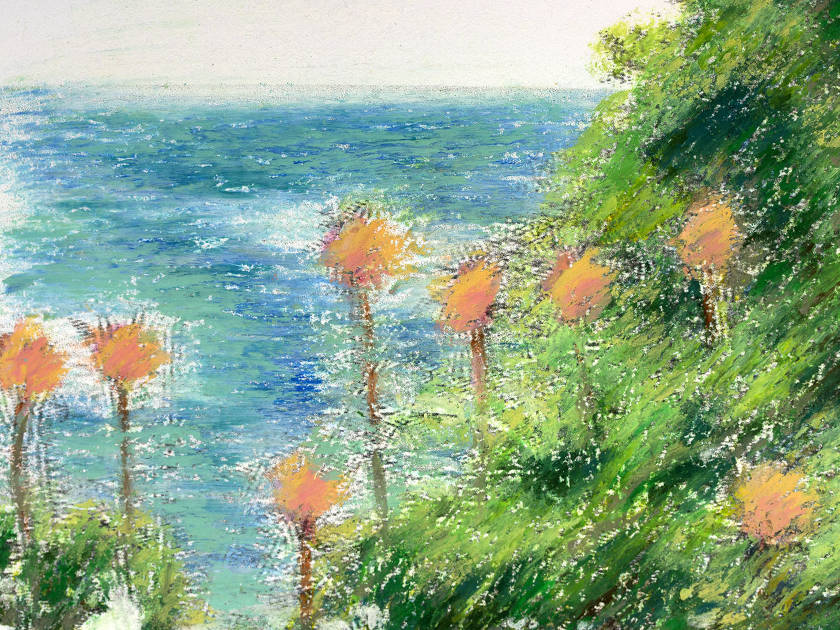
About Sandro Del Rosario:
Sandro Del Rosario's films and installations are inspired by places, feelings and memories of feelings, distilled through a labor-intensive animation process that transforms still images, photos, paintings, and collage in moving imaginary spaces.
Born in Italy, with a background as a multimedia designer, Del Rosario came to the U.S. with a Fulbright Scholarship in 1998, received an MFA in Experimental Animation from the California Institute of the Arts, and currently lives in Los Angeles. His work has been awarded and exhibited in many festivals and venues worldwide, and he traveled extensively as a Visiting Artist and Visiting Assistant Professor at non-profit foundations and universities across the United States.




